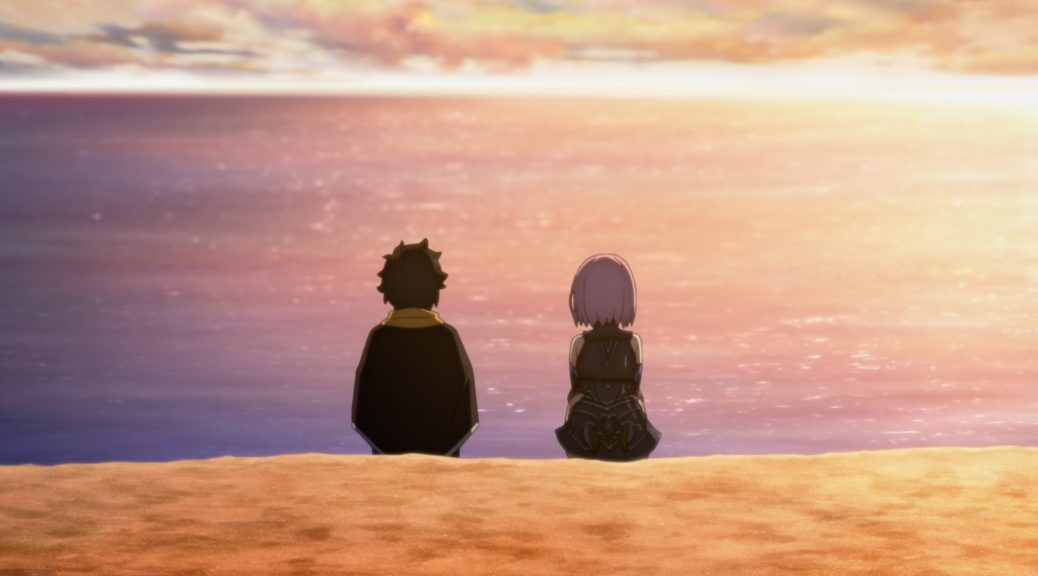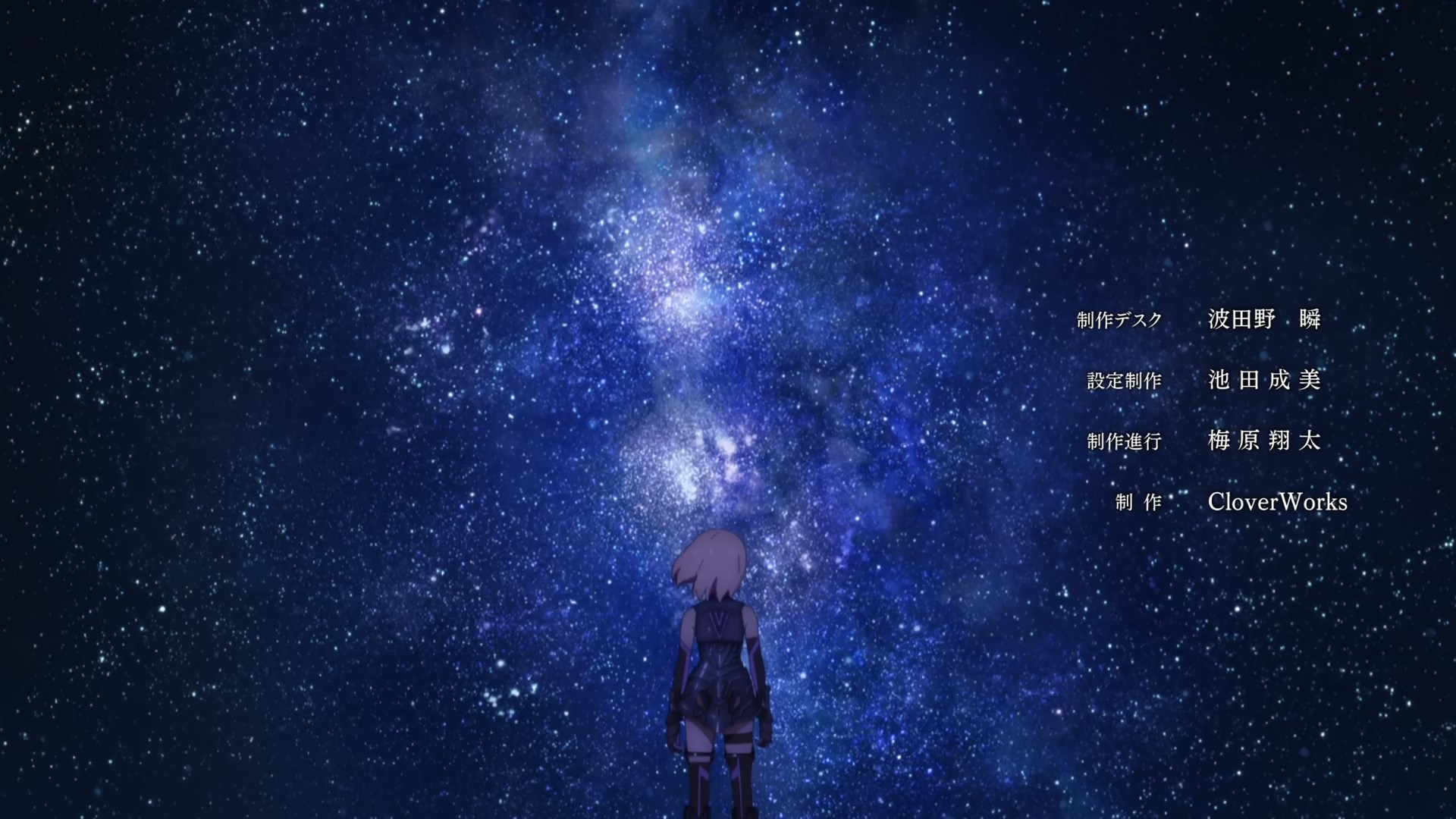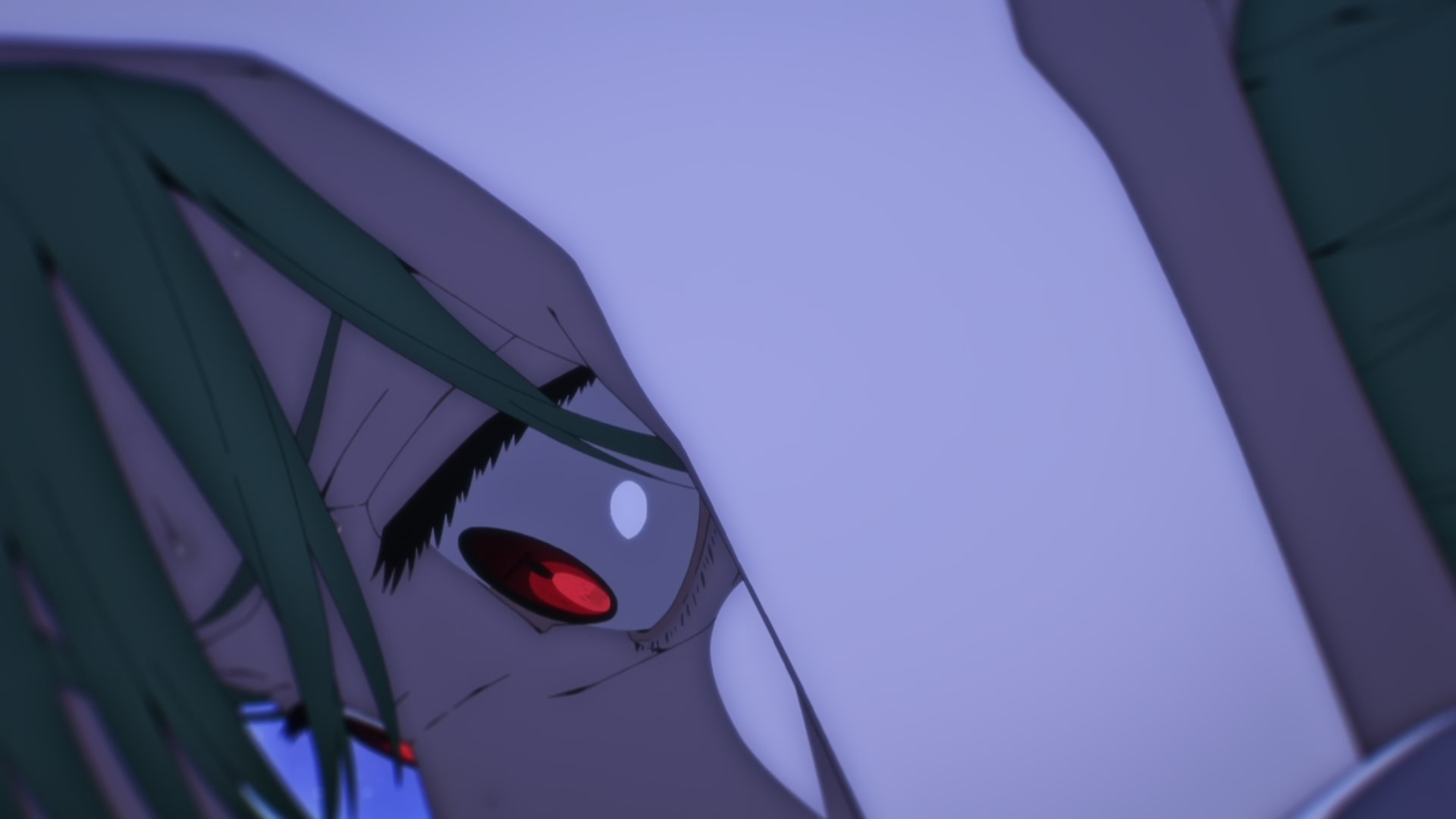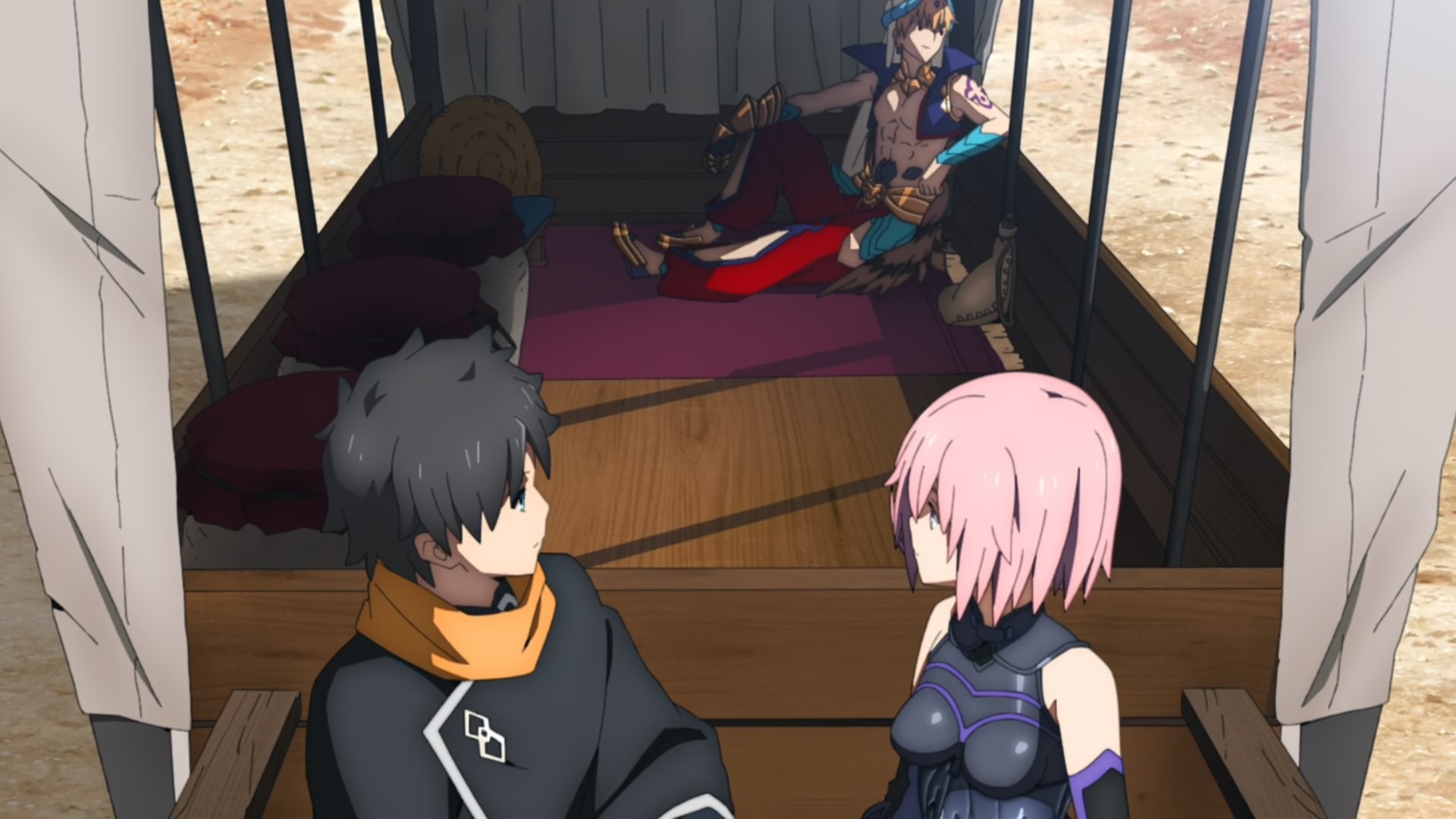
Fate Grand Order: Babylonia #05 And Shouta Umehara: Heroes In the Trenches
Renowned series directors, main writers of notoriety, ace animators in various positions, perhaps some painters acting as art directors or designers – there are some individuals whose name alone can generate excitement, but it’s reserved to a select crew. So how come fans and industry folks alike are clamoring about Fate Grand Order: Babylonia #05’s production assistantProduction Assistant (制作進行, Seisaku Shinkou): Effectively the lowest ranking 'producer' role, and yet an essential cog in the system. They check and carry around the materials, and contact the dozens upon dozens of artists required to get an episode finished. Usually handling multiple episodes of the shows they're involved with., even though that’s anime’s most undervalued role? Let’s learn about how people like Shouta Umehara can make a difference in the field!
I’m not going to surprise anyone by stating that, in an industry where pretty much no one gets the credit and compensations they deserve for their work, production assistants are likely the most undervalued collective; fans tend to either know of their particular pleas or not even be aware that these hard-working people exist at all, which proves the point all the same. To address that somewhat, we published a piece earlier this year to explain their fundamental role in getting any anime made, as well as detailing the problems they face, which are different from the animator struggles that fans are more acquainted with. And to illustrate that as best as possible, we held a survey among production assistants with different backgrounds to showcase their working conditions and the abuse they have to endure. The results were honestly depressing, but spreading awareness felt like a worthy cause.
It’s only been a few months since then, so as you might imagine, the situation hasn’t gotten any better. If anything, the issue is becoming more publicly apparent. We’re right in the middle of a labor dispute involving studio 4ºC and one of the production assistants in Children of the Sea, a breathtaking movie that in no way was worth the pain its crew went through. With the support of the Black Company Trade Union, that production assistantProduction Assistant (制作進行, Seisaku Shinkou): Effectively the lowest ranking 'producer' role, and yet an essential cog in the system. They check and carry around the materials, and contact the dozens upon dozens of artists required to get an episode finished. Usually handling multiple episodes of the shows they're involved with. pushed back against some unarguably illegal labor violations, but 4ºC still refused to compensate them for the many hours of unpaid overtime with the excuse that they weren’t all true work time, leaving them with no option but suing the studio. You’d think that while that gets settled and considering the impactful comments – 100+ hours of overtime in a single month and the constant worry that their pals on neighboring desks might have died on the job – would have at least earned them the support of other workers, but instead we’ve seen veteran animators come out in support of the studio.
【労働問題】アニメ制作会社「STUDIO4℃」社員が提訴「業界で当たり前のように横行」https://t.co/28vGbcdWIG
未払い残業代などを求めた訴訟。『海獣の子供』の制作進行担当で、3月には残業100時間を超えた。長時間労働について「隣の同僚が明日死んじゃうんじゃないかと不安になる」と話した。
— ライブドアニュース (@livedoornews) October 18, 2019
Nasty as that sounds – and it is – it’s actually not surprising if you’re acquainted with the delegitimization of management roles in the industry. Much like it happens with in-betweeners who don’t get treated as real animators, production assistants and the likes are often treated as inherently lesser contributors to anime because they’re not artists. The attitude is distasteful in and of itself, factually wrong because the role is one of the most common avenues to become a director, plus it also plays a role in slowing down any positive change in the industry to a halt; curiously, it’s the same executives quietly content with the status quo, maintaining employment policies that delegitimize the most vulnerable groups in the industry, whom later benefit from the inability of workers to unite and push for industry-wide working improvements. It’s almost as if this was their intent all along.
To sum things up: we’ve got a bunch of management professionals who aren’t only mistreated by their superiors but sometimes by their peers as well. Among them, production assistants are the lowest ranking employees, meaning that they bear the brunt of that. So again: how come animators and sakugaSakuga (作画): Technically drawing pictures but more specifically animation. Western fans have long since appropriated the word to refer to instances of particularly good animation, in the same way that a subset of Japanese fans do. Pretty integral to our sites' brand. fans were both tremendously excited about a production assistantProduction Assistant (制作進行, Seisaku Shinkou): Effectively the lowest ranking 'producer' role, and yet an essential cog in the system. They check and carry around the materials, and contact the dozens upon dozens of artists required to get an episode finished. Usually handling multiple episodes of the shows they're involved with. of all things showing up in an all-stars project like Fate Grand Order: Babylonia?
Shouta Umehara has stood out in an unusual way for someone in his role for quite a few years, and I can’t say there isn’t a good reason for that. He joined studio Dogakobo at the turn of the decade, at a time where they weren’t only blessed with a very gifted generation of in-house animators and similarly talented regular associates, but also equipped with a subversive attitude – one that Umehara quickly came to represent. The webgenWebgen (web系): Popular term to refer to the mostly young digital animators that have been joining the professional anime industry as of late; their most notable artists started off gaining attention through gifs and fanmade animations online, hence web generation. It encompasses various waves of artists at this point so it's hardly one generation anymore, but the term has stuck. movement a few years earlier had set a precedent for a new way to get into the industry, but the daring scouting of young artists with no formal training whatsoever that we see nowadays – though without the international aspect it has now – is more of a watered-down version of the Dogakobo approach back then. It didn’t matter if you were still in high school, if your work caught the eye of their scouting specialists, you could get an offer… and most importantly, they’d surround you with more experienced folks who could guide you properly during your first professional adventures.
Though it’s impossible to pinpoint an exact moment where Umehara came to embody that spirit, looking back on episodes like Nisemonogatari #06 – outsourced to Dogakobo and with him in the lead – is fascinating in retrospect. We’ve got the professional key animationKey Animation (原画, genga): These artists draw the pivotal moments within the animation, basically defining the motion without actually completing the cut. The anime industry is known for allowing these individual artists lots of room to express their own style. debut for artists who are now highly regarded like Tatsurou Kawano, Yusuke “nara” Yamamoto, and Senbon Umishima, as well as other youngsters who did the same under pseudonyms before joining important studios. The episode also featured current freelance aces who were only just starting at the time, like Ryu Nakayama and Atsuki Shimizu. These were all complimented by Dogakobo-adjacent rising stars ala Hirofumi Okita, Kazuaki Shimada, and Masayuki Nonaka, as well as renowned veterans like Takashi Mukouda and Junichiro Taniguchi. All for a single episode in a show that wasn’t even Dogakobo’s responsibility! Umehara quickly proved that his ability to act as a talent magnet didn’t just rival that of popular directors, it actually synergized with them; put him alongside an interesting creator, and other artists with unique voices of their own will flock to your project.
With the ability to gather crews like that, it’s no wonder that Umehara quickly caught the eye of many people. It goes without saying that creators took notice of his ardent enthusiasm and skill – building a rich network of creative acquaintances is the core of a production assistant’s job – but even fans began to pay attention to the person that happened to be tied to the studio’s most impressive showings. By 2013, that was paying off in a big way: the episodes Umehara managed in Love Lab might very well be the greatest animation achievements in the 46 years of the studio’s history, making it worth it to keep track of his appearances in the same way that avid fans follow renowned directors and animators. Back in 2017, we thought it was entirely justified to dedicate part of a news post to reveal that Umehara had departed from Dogakobo and moved to A-1 Pictures, because it felt like a very significant development. And seeing the effect it’s had on both parties, it was.
At this point, you might be wondering why someone who’s seemingly that good at their job hasn’t been promoted to higher roles. We don’t have to speculate about whether he’d be qualified or not, because he has handled higher-ranking management tasks just fine; Engaged to the Unidentified and Plastic Memories made him juggle episode and series management duties, and most notably, he was the animation producer on the charming comedy Sansha Sanyou – his last major project at Dogakobo before leaving them. So, how come he’s back to the trenches as a production assistantProduction Assistant (制作進行, Seisaku Shinkou): Effectively the lowest ranking 'producer' role, and yet an essential cog in the system. They check and carry around the materials, and contact the dozens upon dozens of artists required to get an episode finished. Usually handling multiple episodes of the shows they're involved with., then? The answer appears to be as simple as it gets: because he loves his job that much. His passion for animation and the production process is the real deal, and I can personally attest that I’ve rarely come across someone with such a bright outlook on the job, despite being perfectly aware of the industry’s shortcomings. Umehara enjoys being involved in the process of making anime like few other people, loves working alongside skilled creators, and he’s earned a position where he can do it more or less comfortably.
Now that you know why he’s considered to be kind of a big deal, it’s time to check if he managed to have much of an effect on a project already brimming with talent like Fate Grand Order: Babylonia; I wouldn’t blame anyone for assuming that no individual production assistantProduction Assistant (制作進行, Seisaku Shinkou): Effectively the lowest ranking 'producer' role, and yet an essential cog in the system. They check and carry around the materials, and contact the dozens upon dozens of artists required to get an episode finished. Usually handling multiple episodes of the shows they're involved with. could make a difference on an already all-stars gathering like this, but episode #05 makes a compelling case against that. At first glance, one could assume that this was a slight downgrade on the first episodes as those had more acclaimed artists… but of course, that’s not how things work. At the end of the day, widely known names alone mean nothing. And as undoubtedly well-produced as FGO has been so far, I can’t say it’s been a very characterful series up until this point. In retrospect, Noriko Takao‘s episode #0 did a great job at exteriorizing the main cast’s feelings and providing an emotional groundwork for Mash in particular, but after that, I’d say that only characters who wear their heart on their sleeve like Ishtar, Gilgamesh, and Jaguarman acted out their roles in a way that befits the immense prestige of this production. Not below par by any rate, but clearly not its forte either.
Acting nuance isn’t something you simply press a button to manifest, of course. It usually requires a director/storyboarder with bright ideas when it comes to character expression, an animation team that can expand on that, as well as the right prioritization, since in the world of TV anime, even projects this exceptional make sacrifices all the time. And that explains why earlier episodes, despite having plenty capable crews, sorta pushed animated characterization to the back for the major goal we keep coming back to: making the setting and conflict feel as grand as possible. But this time we’ve got Umehara, who only surrounds himself with people who specialize in giving character flavor to anime, appointed to an episode willing to let its characters breathe and also get dirty when it comes to interpersonal conflict. The right ingredients for a change of pace the series could do with.
Ordet-trained director Yuta Yamazaki isn’t Umehara’s most glamorous acquaintance. It’s hardly a secret that the ace directors he currently enjoys working with the most are the aforementioned ex-KyoAni star Noriko Takao and Shin Wakabayashi, whose realist fundamentals allowed him to quickly become a director capable of conveying a character’s every feeling without forgetting that animation is supposed to be entertaining to watch. You can bet that whenever Umehara is entrusted with a more narratively climactic episode, he’ll be accompanying either of them, depending on disponibility. But it was precisely Wakabayashi’s 22/7 short films – a deceitfully ambitious project that used Yukiko Horiguchi‘s designs and mannerisms to put together a convincing Yamada-like character study in tiny chunks – that got him to admit Yamazaki’s fastidiousness as a unit director had been a tremendous help for the two shorts he handled.
And of course, it helps that in both cases the person leading the animation process was Maiko Kobayashi, an even more thorough character specialist. Though she caught the eye of animation fans working under Yoshimichi Kameda in the animator training project Paroru’s Future Island, all the years she spent working with a studio like Shin-Ei that still holds uncompromised acting as one of their principles made her into an expert when it comes to more down-to-earth character animation. With time, Kobayashi wouldn’t only fulfill the vision the directors had for their character moments, but even gain a reputation for improvising extra gestures that weren’t in the storyboardStoryboard (絵コンテ, ekonte): The blueprints of animation. A series of usually simple drawings serving as anime's visual script, drawn on special sheets with fields for the animation cut number, notes for the staff and the matching lines of dialogue. yet were deemed befitting of their personality, which gave more texture to all her works. 22/7 even allowed her to solo direct and animate one of its pieces, with not only her characteristic detailed gesture work but also with an almost palpable sense of atmosphere you wouldn’t expect from a newbie; betting on her eventually becoming a full-fledged director, and quite the good one at that, seems like a no-brainer. Even Umehara agrees, seeing how he works with her in every single project he touches nowadays.
Looking back at FGO, the laid back first half of this episode doesn’t have too many bells and whistles, but Yamazaki and Kobayashi’s eye for detail manages to shine through in subtle ways. The one that stuck with me the most is the attention to Gilgamesh’s body language; although animating him like a believable arrogant jerk is something other teams have succeeded at before, there’s something more genuinely regal about his gestures this time around, befitting of the side of him we get to see. Even when it comes to minor gestures like his sitting posture, the way he straightens up, or even his pensive figure remain perfectly consistent throughout the episode. Even when the animation doesn’t appear to be outside the ordinary, this team’s ability to establish an actual body language for him in such a short span of time is worthy of praise.
Besides them, there are way more interesting contributors to this episode… is what I would say, except they got away with the smallest list of key animators in the show yet; we’ve got fresh talent scouted by Umehara like Aoi Otani and Yoshiaki Miyagawa, other young stars he tends to work with like fellow Nijisanji appreciator Kerorira right off the bat and Takeuchi-school’s Jin Oyama with the attractive movement in the beach, some FGO action regulars like Kosuke Kato and Shota Goshozono – the latter’s emotional meeting and following action setpiece are a clear highlight – as well as the one and only Keisuke Kobayashi. If I had to choose one animator who exemplifies the other quality that sets apart this episode, whoever, it would be the fan-favorite leaf Ken Yamamoto. With the lack of a dedicated action director in this episode, his arrival couldn’t be more obvious; a bit of a reduction in drawing count with more cycles on the 3s, an imposing increase of the scale of the battlefield that brings to mind his friend Onsen, plus stylized and downright painterly effects that, weirdly enough, feel like they carry emotion as well.
But above everything else: actual expressions. Although the homogenization of the designs under Takashi Takeuchi‘s style is understandable, and Tomoaki Takase’s character art is always appealing, there was always something unsettlingly inert about the way they emoted in the show – perhaps due to strictly sticking to an illustrator‘s style. Yamamoto does away with all that entirely, actually capturing Enkidu’s pain and confusion with their deranged expressions. Something that appears so simple, and yet had been sorely missing from FGO so far. Kobayashi closeups of Enkidu’s bewilderment, so detailed they also escape Takeuchi’s constraints, are another great example of what this series needs more of in the future if it really wants to be emotionally resonant.
As far as I’m concerned, this episode was a step in the right direction for the show, one that feels inseparable from the contributions by Umehara and the crew he gathered. If you’ve read this far, however, I wouldn’t blame you for having a certain nagging feeling; sure, Umehara can gather acting specialists, plus he’s ingenious enough to draw exceptional talent from pools ignored by most, but isn’t that essentially the definition of a good production assistantProduction Assistant (制作進行, Seisaku Shinkou): Effectively the lowest ranking 'producer' role, and yet an essential cog in the system. They check and carry around the materials, and contact the dozens upon dozens of artists required to get an episode finished. Usually handling multiple episodes of the shows they're involved with.? And the answer is… yes. While there’s no denying that Umehara excels at his job, he’s not doing anything fundamentally different from other production assistants. They’re not only there to ensure that everyone’s work gets finished in time – kind of an important role already! – but can also open up new doors for the creative staff, giving them access to the artists they need to fulfill their vision.
And maybe this should be our final takeaway: people are right in being excited about Umehara showing up to manage the making of an episode, but we should funnel some of that energy into appreciating production assistants more in general, because they’ve given much to anime and gotten barely any recognition out of it. They’re the real heroes in the trenches.
Support us on Patreon to help us reach our new goal to sustain the animation archive at Sakugabooru, SakugaSakuga (作画): Technically drawing pictures but more specifically animation. Western fans have long since appropriated the word to refer to instances of particularly good animation, in the same way that a subset of Japanese fans do. Pretty integral to our sites' brand. Video on Youtube, as well as this SakugaSakuga (作画): Technically drawing pictures but more specifically animation. Western fans have long since appropriated the word to refer to instances of particularly good animation, in the same way that a subset of Japanese fans do. Pretty integral to our sites' brand. Blog. Thanks to everyone who’s helped out so far!



This part wasn’t one of my favorite in the game (didn’t hate it either it just left no strong impression) but they still made a masterful episode. Thank you based Umehara
this post got me to finally catch up with fate/go even though i’d sorta fallen off with keeping up a couple weeks back, and i’m delighted by how fricking great episode 5 is??? this is the first time that cloverworks’ adaptation has left me genuinely breathless with an action scene!!! which isn’t meant to be a dunk on the animation quality of the earlier action setpieces, babylonia is full of gorgeous ones–it’s just that this episode in particular had so much emotional substance to it that my investment as a viewer was exponentially higher. personally this kinda Big Feelings Hour… Read more »
Part of it comes down to the narrative – we’d seen many cool skirmishes before, but is this the first fight with truly invested combatants… other than that time Fou wholeheartedly decked the stinky sexy wizard I suppose. That said, Yamamoto’s willingness to stray much further than the design sheets, with fewer supervisors than usual to stop him, really made a difference here in showing this was the real deal. And as you said, it might have captured what Takeuchi is going for better than religiously replicating his standard expressions.
I clicked as soon as I watched the episode because HOLY CRAP KEN YAMAMOTO’S SCENE. Speechless. Thank you for highlighting this (and the work of production assistants too)
great article as always. promoting appreciation for Production Assistant to the point first half of article is not even FGO related is abit overkill tho XD. back to the actual content of the article, this is my first time discovering umehara and see some familar names within his crews. the second half of the episode is indeed the main course, the action scene is clearly one of the best from this season as for now tho in my opinion its not perfect. while its probbaly just how Yamamoto’s rolls, i think some parts where the sand getting blown by shockwaves… Read more »